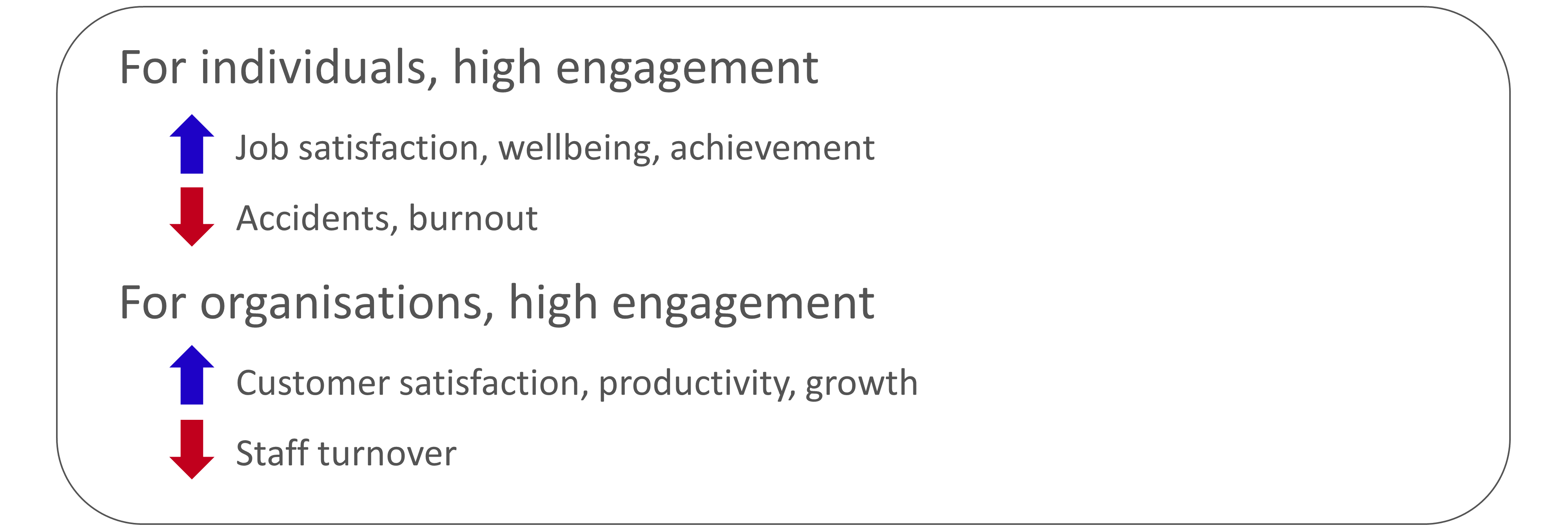Increasing engagement
-
 Overview
Overview -
 Exercises
Exercises
Overview
In practice: Looking for ways to improve the environment in which your staff will thrive, and regularly making time to understand the needs of your staff as individuals.
‘Engagement’ expresses an individual’s level of enthusiasm about, and personal investment in, their work or their organisation..
There is considerable evidence that ‘engaged’ individuals are more physically, cognitively and emotionally involved in their work. This makes engagement of huge interest if we want to help each other to experience work as fulfilling and to achieve the best we can – for two reasons:
- Engagement has been shown in numerous studies to have a significant influence on both performance and well-being.1
- We actually know from research what drives engagement, and the factors that increase and reduce it. In principle at least, we should be able to provide workplaces where engagement is high and people thrive.2
Let’s look at each of these in more detail.
The potential
The explosion of research interest in engagement since 2000 has increased awareness of significant benefits for both individuals and organisations. Its benefits are numerous and well-documented3. For example:

When do we feel engaged?
When we experience engagement at work we feel a sense of positive energy, focus and interest in what we are doing. Of course, we have the normal ups and downs of working life, but overall we have an active sense of positive involvement in our work and workplace.
Researchers have discovered three fundamental conditions for this to happen:
- We need to feel a sense of significance and meaning in our work, and its contribution to something that is important to us. We experience this when we feel worthwhile, useful, and valued.
- We need to feel we have the right resources to do the job we are asked to do – physically and psychologically.
- We need to feel safe – again physically and psychologically. (Psychological safety is the feeling that we can express our true self without fear of negative consequences).
These conditions - significance, resources and safety – are quite possible for us to provide and receive if the desire and the determination are there. The evidence is quite clear that organisations, leaders and individuals can all play a critical role in providing the conditions for high engagement. Which will in turn produce massive benefits for the organisation and its people. Here is what you can do:
Increasing engagement - the evidence
What organisations can do
The evidence highlights immediate targets for organisations to focus on. From the most basic ‘hygiene factors’ as a start to the more inspirational ‘motivating factors’ :
- Working conditions that are physically safe from health hazards, temperature, noise
- Adequate resources for the job – fairness in not asking people to do more than is reasonable, and justly rewarding and recognising their achievements
- Challenging but do-able jobs with variety – and where appropriate with the opportunity to solve problems
- Opportunities for personal learning and development
And finally addressing as a priority two factors that are known to destroy engagement – minimizing administrative hassles and organisational politics.
What top management can do
Leaders at the very top of the organisation have a significant role to play in creating the organisation described above. But, in addition, your leadership style plays an important role in creating a positive workplace climate from the top. It is not just ‘what’ is done but ‘how’ it is done that engages people.
There is evidence that leaders who communicate an inspiring vision, lead by example, and are seen as trustworthy and optimistic are more likely to develop a highly engaged staff. (Links to separate briefings on these topics are shown at the end of this page).
What team leaders can do
Additionally, team leaders everywhere in the organisation can build engagement, and enhance individual wellbeing.
Leading by example and being seen as trustworthy and optimistic are essential, just as they are for top managers. But because team leaders are so close to their team members they can do much more. There is good evidence that the following build people's engagement.
Team leaders can increase a team's engagement by:
- Providing psychological safety (one of the fundamentals for engagement) by the support and recognition they are seen to give team members. When they treat people fairly, and praise and recognise people’s contributions they take a big step in helping people to feel safe and engaged.
- Expressing confidence in the team's ability to achieve great things. They help to develop a can-do culture by giving members autonomy and making sure they don’t micro-manage team members - by delegating responsibility and authority, sharing information, involving members in decision-making and encouraging them to take initiative.
- Helping team members to develop their skills and careers. Providing training opportunities, high visibility development assignments and secondments, and fair recommendations for promotion will all build engagement. But just as important is enlarging people’s skills by the simple and cost effective method of giving constructive and fair feedback and coaching people to think in new ways.
See our briefing on how to develop a can-do culture and empower people in the 'Related topics' at the foot of this page.
What individuals can do
There is also plenty we can do as individuals to enhance our own engagement, and that of our colleagues, by being supportive and constructive co-workers, building trusting and optimistic relationships and recognising the contributions we all make. Cynicism – the belief that people are selfish and insincere – sours organisations and teams, and impedes the development of a culture where wellbeing and achievement can flourish.
1. Saks, A.M and Gruman J.A, 2014 What do we really know about employee engagement?, Human resource Development Quarterly, 25 -2, 155 - 182
2. Knight, C et al, 2017, Building work engagement: A systematic review and meta-analysis investigating the effectiveness of workplace interventions, Journal of Organizational Behavior, 38, 792 - 812
3. See eg Gallup 2013 State of the Global Workplace.
Exercises
Exercise - Creating an Empowered and Optimistic Culture
The aim of this exercise is to look at how you / your team talk about events - past, present or future - and see how you could view them in a more optimistic and empowering way.
Exercise - Improving your 'inspirational appeal' influencing style
This exercise gives you a practice scenario to help you influence people through an 'inspirational appeal' approach.
Exercise - Improving your 'collaborative' influencing style
This exercise gives you a practice scenario to help you influence people through a 'collaborative' approach.
Exercise - Reflecting on your personal experience of trusting someone at work
This exercise helps you to understand what makes people trust each other
Exercise - Review your own track record on trust
This exercise will help you to review whether you behave in a way to earn people's trust
Exercise - Reviewing your 'explanatory style'
An exercise to reflect on the way you describe positive and negative events.
